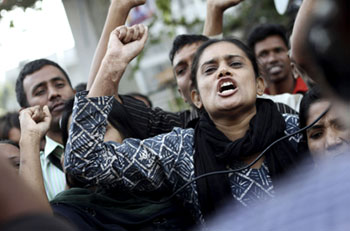

Vol. 76/No. 45 December 10, 2012

|
| AP Photo/Ashraful Alam Tito |
| Nov. 27 protest in Dhaka, Bangladesh, after fire killed 112 workers in garment factory. Workers are demanding job safety, compensation for injured and killed, and prosecution of owners. |
The fire at the Tazreen Fashions factory also injured scores of workers.
After the fire started supervisors initially told workers trying to leave the building not to worry and to go back to work, reported Dhaka’s Daily Star. According to the paper, windows had been bolted shut and there were only three staircases for the building’s 1,700 workers, all leading to the same exit. And two of those staircases were locked.
Firefighters trying to reach the blaze were slowed because the narrow road leading to the factory made it difficult to get to the site and there was no source of water nearby, the paper said.
Tazreen is a subsidiary of the Tuba Group, which exports clothes to Walmart, Carrefour, and Ikea, among others. Walmart claims that a supplier subcontracted work “in direct violation of our policies.” In a Nov. 26 statement Walmart announced they “terminated the relationship with that supplier.”
Bangladesh is rapidly becoming a center of world garment production. The garment industry there ranks second after China, employs 3.6 million workers, mostly women, and accounts for 80 percent of the country’s exports. Since 2006 more than 500 workers there have died in factory fires.
“They are the lowest paid garment workers in the world, their minimum wage is $37 a month. They only get overtime pay after they work 208 hours in a month,” Kalpona Akhter, a leader of the Bangladesh Centre for Worker Solidarity, said in a Nov. 27 phone interview from Dhaka.
Akhter visited the Tazreen factory after the fire. “Many of the emergency exits were locked,” she said. “There was cloth and yarn in the exits. That’s one reasons the death numbers are so high.”
“There was no union in the factory,” Akhter noted. “Out of more than 4,000 factories only 20 to 25 have unions. A union would negotiate with management to demand fire drills and proper emergency exits.”
Union organizing in Bangladesh is challenging, she said “because whenever workers organize, they are harassed by the police, security, and the companies’ hired goons and even can get killed like my colleague.”
Akhter was referring to Aminul Islam, a union leader who was tortured and killed in April. While the police say they are still investigating, no one has been charged with his murder.
In July 2011 Akhter and other leaders of the solidarity center were indicted on frame-up charges of criminal intimidation, violence against civil servants, mischief causing damage, and unlawful assembly in relation to a June 2010 protest at a garment factory operated by the Nassa Group.
The case is aimed at making it difficult to back efforts at organizing garment workers, Akhter said. “They make us appear in court seven to 10 days every month. And we have no idea how long this will go on or when the case will go to trial.”
“No union organized yesterday’s protest,” Akhter noted. “It was just the workers themselves. Their back is to the wall so they started coming forward.”
Related articles:
Calif. postal workers protest privatization, layoffs, cuts
On the Picket Line
Report: Bosses at fault in deaths of 29 New Zealand miners in 2010
Worker killed on job at Peabody mine in Illinois
3 die, 18 injured in Quebec plant explosion: ‘There was no safety’
No worker has to die on the job!
Millions forced into part time as bosses cut costs, drive speedup
Front page (for this issue) |
Home |
Text-version home